
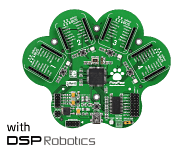
|
FlowPaw Released

FlowPaw is a development board intended to inspire the next generation of kids to get involved in computer science, engineering and mathematics. It does that by making learning to code fun and engaging, keeping the learner motivated with small wins, and keeping the imagination going with with click boards. The FlowPaw kit comprises the paw-shaped main board, the FlowStone STEM graphical programming software, and four click boards, with additional click board packs sold separately.
|
2015/01/08 |

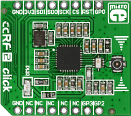
|
ccRF2 click Released

ccRF2 click carries CC1120, the fully integrated, high-performance single-chip radio transceiver with extremely low power consumption. Designed mainly for the ISM (Industrial, Scientific, and Medical) and SRD (Short Range Device) frequency bands at 164–192 MHz, 274–320 MHz, 410–480 MHz, and 820–960 MHz, CC1120 provides extensive hardware support for packet handling, data buffering, burst transmissions, clear channel assessment, link quality indication, and Wake-On-Radio. It also has exceptional receiver sensitivity. ccRF2 click communicates with the target board through mikroBUS SPI (MISO, MOSI, CSK), and AN, RST, CS, PWM and INT lines. The board is designed to use a 3.3V power supply.
|
2015/01/08 |

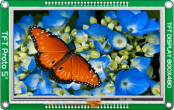
|
TFT Proto 5" Released

TFT Proto 5" carries a 800x480 HT050AWV40T TFT screen covered with a 4-wire resistive touchscreen panel. To drive the 262k-color display, there's an SSD1963 graphic controller with a 8/9/16/24-bit MCU interface that includes a deep-sleep power saving mode (accessed through the GPIO0 pin on the side of the board). The touchpanel is driven by an advanced STMPE811 controller. The board is lined with two rows of 26 pins for interfacing it with your MCU. TFT Proto 5" uses a 3.3V power supply only.
|
2015/01/08 |

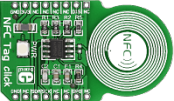
|
NFC Tag click Released

NFC Tag click carries an M24SR64 NFC/RFID tag IC with a dual interface and 8KB of high-reliability EEPROM built-in. The RF protocol is compatible with both NFC Forum Type 4 Tag and ISO/IEC 14443 Type A. There are three ways to operate NFC Tag click: 1) from an I2C interface; 2) by a 13.56 MHz RFID reader; or 3) from an NFC-enabled smartphone, tablet, and similar device. NFC Tag click communicates with the target board through mikroBUS I2C (SCL, SDA), INT and RST lines. It uses a 3.3V power supply only.
|
2015/01/08 |

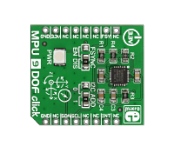
|
MPU 9D0F click (Accel, Gyro, Fusion, Separate Mag) Released

MPU 9DOF click carries the MPU-9150 System in Package, which is the world's first 9-axis Motion Tracking device. MPU-9150 comprises two chips. One is the MPU-6050 that contains a 3-axis accelerometer, a 3-axis gyroscope, and a DMP (digital motion processor); the other is AK8975, a 3-axis digital compass. The MPU-9150 is designed for the low power, low cost, and high performance requirements of consumer electronics equipment and wearable sensors. The ability to track motion in free space also makes MPU 9DOF click a suitable sensor for RC vehicle (e.g. quadcopters) and camera stabilisation systems.
|
2014/12/08 |

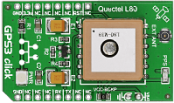
|
GPS3 click Released

GPS3 click carries Quectel's L80 GPS module, a high-sensitivity ultra slim GPS module with a patch antenna. The module incorporates several technologies that enhance the GPS performance. EASY Technology ensures that L80 can calculate and predict orbits automatically using data stored in its internal flash memory. AlwaysLocate technology adaptively adjusts the on/off time to balance between positioning accuracy and power consumption. The Automatic antenna switching function enables switching between the internal patch antenna and the external active antenna, keeping positioning during the switching process.
|
2014/12/04 |

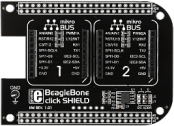
|
BeagleBone click Shield (Cape) Released

BeagleBone click shield is an extension for Beaglebone black, the popular low-cost development platform running Linux. This simple click shield (or cape if you prefer) has two mikroBUS sockets that allow you to connect more than 90 different types of click boards to BeagleBone black. It also has an EEPROM chip for storing pin configuration data. Quickly add functionalities like GSM, GPS, WiFi, ZigBee, Bluetooth, or thunder detection, proximity and color sensing and so on. The package includes two 2x12 headers and single 1x6 headers.
|
2014/11/24 |

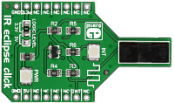
|
IR Eclipse click Released

IR eclipse click carries an EE-SX198 photo interrupter sensor. This sensor consists of an infrared transmitter and receiver facing each other and spaced apart by a 3mm slit. When the beam from the transmitter is eclipsed by placing an object in the slit (like a piece of paper), the sensor is activated (indicated by the onboard INT LED). This type of sensor is typically used in printers, copiers, vending machines and so forth. IR eclipse click communicates with the target board through the mikroBUS INT line. It’s designed to work with either a 3.3V or 5V power supply.
|
2014/11/24 |



|
WunderBar Released

The WunderBar makes it easy for Android and iOS app developers (as well as web developers) to receive data from remote hardware sensors via the internet. It consists of a WiFi-enabled main module and various wireless sensor modules. Data from the sensors is automatically sent to the cloud, and can be retrieved via iOS, Android and node.js SDKs.
|
2014/11/05 |

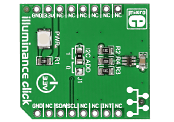
|
Illuminance click Released

Illuminance click carries a TSL2561 light-to-digital converter with a sensor that's designed to mimic the way humans perceive light. This makes it ideal for applications where ambient lighting conditions have to be measured (backlight power-saving on LCD displays for example). The sensor has two photodiodes. One sensitive to full-spectrum light, the other to infrared. The visible-spectrum is then deduced by using a formula. Illuminance click communicates with the target board through mikroBUS I2C lines, and uses a 3.3V power supply.
|
2014/11/05 |

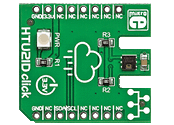
|
HTU21D click (Temperature / Humidity Sensor) Released

HTU21D click carries a high-precision, easy-to-use relative humidity sensor with temperature output. It's a great solution for quickly developing reliable environmental sensing nodes. The sensor is plug and play, requiring no calibration to use. The measurement range of HTU21D click is from 0 to 100 percents of relative humidity, and -40 to +125 degrees of Celsius. The board communicates with the target microcontroller through mikroBUS I2C lines: SCL (clock) and SDA (data). The default resolution of the signal is set to 12-bit for relative humidity and 14-bit for temperature readings. HTU21D click uses a 3.3V power supply.
|
2014/10/21 |

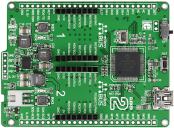
|
clicker 2 for PIC18FJ Released

clicker 2 for PIC18FJ is a compact dev. kit with two mikroBUS sockets for click board connectivity. You can use it to quickly build your own gadgets with unique functionalities and features. It carries an 8-bit PIC18F87J50 device, preloaded with a fast USB-HID bootloader (no programmer necessary). The board also features a li-po battery connector and LTS3586-2 power management IC. Additional features include 2x26 connection pads on the sides of the board, and some buttons, switches and LEDs.
|
2014/10/17 |

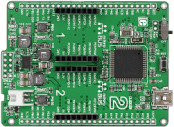
|
clicker 2 for STM32 Released

clicker 2 for STM32 is a compact dev. kit with two mikroBUS sockets for click board connectivity. You can use it to quickly build your own gadgets with unique functionalities and features. It carries STM32F407VGT6, a 32-bit ARM Cortex-M4 microcontroller, with a built-in USB-HID bootloader that makes it easy to program. A JTAG connector is also available. Whichever way you upload the firmware, you can turn clicker2 into a standalone gadget because it has a li-po battery connector. The battery (sold separately) can be charged via USB thanks to the LTC3586-2 power management IC that can also provide an independent power supply to the MCU's RTC. Additional features include 2x26 connection pads on the sides of the board, and some buttons, switches and LEDs.
|
2014/09/29 |


|
OLED C Click (Colour) Released

OLED C click lets you add a small but bright and crisp 1.1" full-color display to your design. It carries a passive matrix OLED display capable of displaying 65K colors, and a SEPS114A display driver and controller. The controller has numerous built-in functionalities like vertical scrolling, horizontal panning, fade in/out, a programmable panel size (partial display), a power saving mode and more. OLED C click communicates with the target board through mikroBUS SPI lines: CS, SCK, and MOSI (SDI); and AN (R/W), PWM (A/C) and RST lines. OLED C click uses a 3.3V power supply.
|
2014/09/23 |

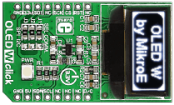
|
OLED B/W Click (Monochrome) Released

OLED click carries a 96 x 39px white or blue monochrome passive matrix OLED display. The display is bright, has a wide viewing angle and low power consumption. To drive the display, OLED click features an SSD1306 controller. It's built-in functionalities include contrast control, normal or inverse image display, vertical and horizontal scrolling functions and more. OLED click can communicate with the target board MCU either through SPI or I2C mikroBUS lines. You switch between output options by resoldering the onboard SEL COMM jumpers (J1, J2 and J3) to the appropriate position. OLED click uses a 3.3V power supply.
|
2014/09/19 |


|
GSM Library v3 Released!

After many hours of work, our GSM Library v3 is finally ready for release. New features include HTTP GET and POST GPRS operations for SIMCom modules (such as those featured on our SimPLC/SimPLCv2), reading/writing the GSM modules RTCC (real-time calendar and clock), reading the modules IMEI, and entering a SIM card PIN code if required.
The library has been completely re-packaged and made easier to use - it is now provided as a mikroElektronika compiler library package, with easy installation via Package Manager. We have also written an in-depth User Manual and written more Example Programs. Enjoy! :-)
|
2014/09/18 |

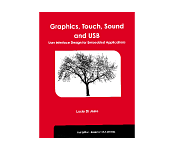
|
Graphics, Touch, Sound and USB Released

Graphics, Touch, Sound and USB is a course book on designing user interfaces for embedded applications, using a mikromedia for PIC24 as the learning tool. It contains eight chapters of gradually increasing complexity, taking you from "Hello World" to interfacing the mikromedia to a PC with USB by creating HID class custom devices and CDC class virtual serial ports.
It is not, however, a beginners course, requiring C programming skills and basic knowledge of 16 and 32-bit microcontrollers and their peripherals (I/Os, timers, PWM, SPI and I2C).
Note: If you're a beginner, you should consider some of the introductory books on PIC programming that are available to read for free online.
|
2014/09/12 |


|
STM32 M4 clicker Released

STM32 M4 clicker is an amazingly compact starter development kit which brings innovative mikroBUS host socket to your favorite microcontroller. Connect the desired click board to enhance it with awesome features. It's preprogrammed with fast USB HID bootloader. Use it to upload your firmware and clicker will become a working device. Board features all you need to get started: 32-bit STM32F415RG microcontroller, USB connector, two LEDs and push buttons, reset button, mikroProg connector and headers for interfacing with external electronics.
|
2014/09/08 |

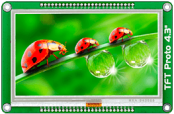
|
TFT Proto 4.3" Released

TFT Proto 4.3" carries a 480x272 ATO43B35 TFT screen covered with a 4-wire resistive touchscreen panel. To drive the 262k-color display, there's an SSD1963 graphic controller with a 8/9/16/24-bit MCU interface that includes a deep-sleep power saving mode (accessed through the GPIO0 pin on the side of the board). The touchpanel is driven by an advanced STMPE811 controller. The board is lined with two rows of 26 pins for interfacing it with your MCU. TFT Proto 4.3" uses a 3.3V power supply only.
|
2014/08/29 |

|

